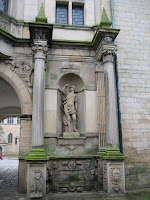Ladies and gentlemen, I have just done a terrible thing.
(And no, I'm not talking about purposely vacuuming up live spiders. That was yesterday, and I don't feel nearly as guilty about that as I probably should.)
No, what I'm talking about is a grave, grave sin. The sin of waste. The crime of Throwing Something Away, Even Though it Might be Useful Later.
Given that I'm moving overseas in about a month, I thought I ought to go through my drawer and see what, in that overstuffed tangle of pyjamas-that-need-mending, embarrassing panda socks and holey, laddered hosiery, I could actually get rid of.
"I'm clearing it out," I told myself sternly. "Anything unwearable goes."
I pulled out a couple of nice pairs of pantihose, well-worn favourites. "Lovely," I said. "Just a couple of holes, a ladder here, a tiny ladder there. Nothing a bit of clear nail polish won't stop. Nothing that can't be hidden by a longish skirt and a pair of knee-high boots. No. I 'll keep them."
And then I pulled out a pair of footless teal tights. "Haven't worn them in a while," I admitted. I examined the three ladders extending downwards from the seam. By my own logic, the flaws could be hidden, so the tights were still wearable. But something inside me said, "I'm not going to wear them again," and I snapped. I put them down on the floor, starting a pile destined for the bin.
Every fibre of my being screamed, "Noooooooo! They might come in handy! You could use them to tie a tomato plant to a stake! You could use them to hang out a wet woolly jumper on the Hills Hoist clothesline! Don't throw them away! Old tights are worth their weight in clothes pegs, at the very least!"
I looked at the tights sadly, drew myself up to my full height, and reminded myself that the days of tomato plants were left behind when I moved out of Mum and Dad's place. I don't grow plants. I don't have a garden (just two pots of herbs that I'll have to leave behind when I move). Worst of all, I don't even live in the same hemisphere as my parents, so my tights are no good to their garden, either... and they don't have much water, anyway, so their need to stake plants is significantly less than it used to be.
Naturally, I don't have a Hills Hoist, either. I have a weird clothes rack with wings, an evil washer-dryer, and, for my heavy woollies and things that might stretch while drying, a couple of nets on curved frames, so I can lay the clothes flat. (Note: don't hang these off your shower rail. It will rip out of the wall.)
It's time for me to get used to this simple fact: old, unwearable tights have no use in my life anymore, and they're no good to anyone. They're just taking up space in my drawer, and if I keep them, they'll only add to the expense of moving, along with all the other useless junk that ought to go out, and would have, but for that voice in my head screeching, "what a waaaaste!".
And so, the tights are in the bin (under some food scraps by now), along with some unfixable, falling-apart knickers, some laddered knee-high stockings, an old, now ill-fitting bra with rust stains, and a pair of socks which are in good condition, but which, let's be honest, I just hate.
Now I need to work out what to do with the several pairs of perfectly serviceable, opaque blue tights that I've had, unused, in my drawer for at least 12 years (when I stopped wearing them to school). I consider them a mental-health hazard. Nightmares about being back at school are bad enough, let alone daytime flashbacks caused by wearing part of my old uniform. But I can't give them away; who wants second-hand pantihose? (No... don't answer that.)
So perhaps, unless I happen to meet someone who needs to stake some plants, I might go a sin further and Throw Away Something in Perfectly Good Condition.
Priests on standby, please. Confession coming soon.
 The Chinese House, which sits in beautiful Park Sanssouci, Potsdam, is known to my daughter as the "pretty house".
The Chinese House, which sits in beautiful Park Sanssouci, Potsdam, is known to my daughter as the "pretty house".






















